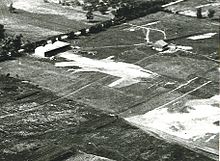Long Branch Aerodrome
The aerodrome was one of several in the Toronto area, including three near Downsview. For many years it was the site of Ontario Power Generation's Lakeview Generating Station. As of 2009 it became a brownfield site awaiting redevelopment.
History

The airfield was opened on May 20, 1915, by Curtiss Aeroplanes and Motors Company for the Royal Naval Air Service and the Royal Flying Corps. Aircraft such as the Curtiss JN-4 "Jenny" and the Curtiss F-type flying boats soon became a common sight at the airfield. John Alexander Douglas McCurdy, the first person to fly an airplane in the British Empire, was hired as the airport's first manager. The airport had a small corrugated metal hangar with space for three small aircraft and a barnhouse. There was no runway, but a grass/dirt strip for landing.

In January 1917, the newly designated Royal Flying Corps Canada, opened the RFC training centre at Long Branch. The Long Branch training centre also provided instruction on flying boats at nearby Hanlan's Point on Toronto Islands, the first seaplane base in Canada. By July 1917, the flight school relocated to Armour Heights Field. Long Branch became the Cadet Ground Training School for the Royal Flying Corps. Both the school and the aerodrome closed in 1919. During World War II, the former aerodrome served initially as Non-Permanent Active Militia's No 21 Training Centre and then as an army small arms training centre.
After the war, the Lakeview Armoury was established on the site, but was demolished in the 1950s.
In 1967 Richmond College, predecessor to Canada Christian College, established their first campus here.
See also
References
- ^ Development of Canadian Airports
- ^ Long Branch Archived 2009-01-05 at the Wayback Machine
- ^ Canada’s First Aerodrome: Long Branch Curtiss Aviation School by Liwen Chen
43°34′26″N 079°33′16″W / 43.57389°N 79.55444°W